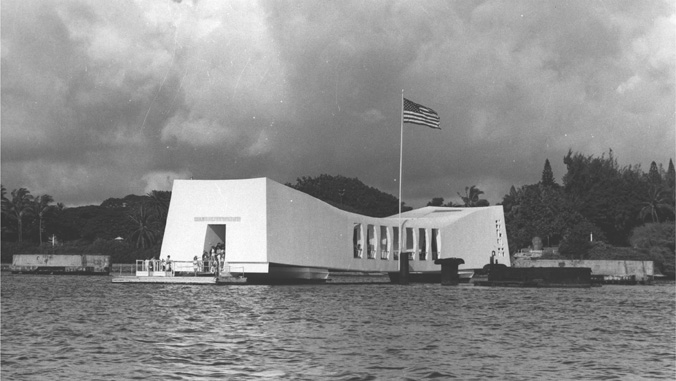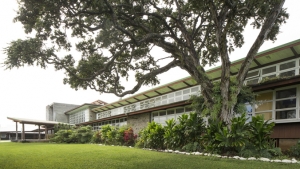
Alfred Preis, one of the most important modernist architects in Hawaiʻi in the mid-century and known for his design of the famed USS Arizona Memorial, was honored via an online exhibition co-curated by a University of Hawaiʻi at Mānoa assistant professor in the School of Architecture in January.
Laura McGuire, assistant professor of architectural history, theory and criticism, co-curated the exhibition with Axel Schmitzberger, a professor of architecture at Cal Poly Pomona, through the Hawaiʻi Arts Alliance. At the exhibition opening, she gave a talk on Alfred Preis’ life, his community involvements, and his important relationships with progressive social causes such as the labor movement, with his design for the International Longshoremen and Warehouse Union headquarters in Honolulu.
“I also discussed his interest in combining architectural ideas of the multi-ethnic population on the islands, including Native Hawaiian and Japanese architectural forms to better reflect Hawaiʻi’s many cultures,” McGuire said.

Preis’ work had largely not been known until McGuire received a $60,000 grant from the National Endowment for the Humanities to research his life and work.
“This work is important to the UH community and state because it sheds light both on the history of Hawaiʻi, along with the work of one of its greatest mid-century architects,” said McGuire. “Preis’ life and work cannot be separated from the social, economic and cultural history of Hawaiʻi because his commissions and designs were shaped by those influences.”
More on Preis’ life
As an Austrian refugee from the Nazis, Preis was arrested as a potential enemy alien after the bombing of Pearl Harbor. This experience—and being a Jewish person whose entire family left in Austria was murdered in concentration camps by the Nazis—caused him to become committed to progressive racial and social causes in the islands’ political and social spheres.

Other examples of his work include how the islands coped with material shortages after the war and how Preis articulated the value of locally-sourced materials. He also constructed hundreds of homes for low-to-middle-income state residents, defining himself as an architect not for the elite, but as a designer for the people of Hawaiʻi.
“The project thus sheds light not only on Alfred Preis’ influential work but on Hawaiʻi’s own history during a period of rapid architectural development, its political revolutions towards progressive liberalism, and the design of humane accommodations for the population at large, especially in his work to construct developments for the growing population amid housing crises,” said McGuire. “It also articulates how Hawaiʻi was on the cutting edge of public arts promotion in the U.S.”
View the online exhibition on Alfred Preis.
This event is an example of UH Mānoa’s goal of Excellence in Research: Advancing the Research and Creative Work Enterprise (PDF), one of four goals identified in the 2015–25 Strategic Plan (PDF), updated in December 2020.

